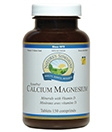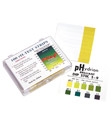How Minerals are Responsible for pH Balance
A recent seven-year study conducted at the University of California, San Francisco, on 9,000 women showed that those who have chronic acidosis are at greater risk for bone loss than those who have normal pH levels. The scientists who carried out this experiment believe that many of the hip fractures (prevalent among middle-aged women) are connected to high acidity, caused by a diet rich in animal foods and low in vegetables. This is because the body borrows calcium from the bones in order to balance pH.
American Journal of Clinical Nutrition
To keep your pH in balance, your body has natural buffering systems that require adequate mineral reserves. Because our society is starving for minerals that are lacking in our food chain, the buffering systems are under-performing. Without adequate mineral supplies, your body cannot compensate for excess acids. The buffering systems use primarily calcium and magnesium, plus sodium and potassium. Sulfur and phosphorus are involved in large amounts in metabolic processes. Trace minerals are referred to as such because they are required in smaller amounts, not because they are of lesser importance.
When your body is low on mineral reserves (most of us are), acidic events such as ingesting refined foods, cigarettes & alcohol, environmental toxins, lack of sleep, and stress will take your body out of balance for extended periods. With this continual exposure to acidic conditions, caused by low mineral reserves, your body's buffering systems are unable to correct your pH balance.
When your body is unable to excrete all the acidic compounds, it accumulates and stores them inside cells, causing an acidic cellular pH. To compensate and balance your overall ionic content, your blood becomes more alkaline, because for every molecule of stored cellular acid, an alkaline molecule needs to be put into the blood, to later escort the acid from your body. This is the body's amazing compensatory mechanism at work.
When your blood is overly alkaline, it becomes saturated with oxygen. Overly alkaline blood holds onto oxygen, unable to release it, thus depriving your cells. This cellular oxygen deficiency is the perfect environment for many serious diseases to thrive. With overloaded buffering systems, more acid accumulates in your bodily fluids. In its initial attempt to compensate, your body will use easily reacting potassium, magnesium and sodium to normalize pH levels. In later stages, calcium (the most alkaline mineral) is drawn out of your bones into your blood, in an effort to restore normal pH. This is called free calcium excess, brought about by an increasing acidic cellular environment throughout the body. This is the cause of osteoporosis (calcium taken out), and arthritis (calcium settling in wrong places).
The body will always seek to balance its pH, even at the expense of its own long term health. The door is open to a host of serious diseases, including faster aging.
Four Minerals that Control Your Autonomic Nervous System
Calcium and Magnesium regulate the sympathetic nervous system (SNS) which controls our "fight or flight" reaction.
SNS is stimulated by calcium, and inhibited by magnesium. Imbalance causes SNS dominance, an uptight nervous, jittery person. Magnesium will calm you down and bring back your sunny personality.
Potassium and Sodium regulate the parasympathetic nervous system (PSNS), which controls our "rest & digest" reaction.
PSNS is stimulated by potassium, and inhibited by sodium. Imbalance causes PSNS dominance (quite rare) a lethargic, tired, slow moving person. Supplementing potassium will revive you out of the evening fatigue.
The Result of Mineral Imbalance on Your Autonomic Nervous System
Free excess calcium will over-stimulate your SNS, because there's insufficient magnesium to balance. Potassium is depleted, so the PSNS cannot be properly stimulated to offset the SNS. If you have an acidic cellular environment and free excess calcium, you'll have an imbalance between the SNS and the PSNS of your autonomic nervous system. This can cause you to be hyperactive, quick to anger, nervous & jittery, and burnt out (like many people in our fast paced society). If pushed to the extreme, a person may appear to be PSNS dominant (lethargic, tired & slow), but this is very rare. This person is past SNS dominance into utter exhaustion.
Magnesium to Calcium Ratio
This ratio between calcium and magnesium is very important in dealing with the cause and prevention of a number of disorders, including cardiovascular, heart and blood pressure illnesses. The absorption and metabolism of magnesium depends upon calcium intake, and vice versa. The balance between these two minerals is extremely important. In view of the overwhelming benefits of magnesium, the traditional ratio of approximately 2 parts calcium to 1 part magnesium needs to be revised. The ideal ratio for most people's needs is equal amounts of calcium and magnesium. If calcium consumption is high, then magnesium intake also needs to be high.
Note: The trace mineral boron plays a part in preventing the urinary loss of calcium and magnesium. Also, silicon aids in calcium absorption. . Take calcium/magnesium with acids (vitamin C, lemon water, apple cider vinegar or betaine HCl) to help dissolve and metabolize it. If it is not, use a stronger push with a mix of two parts baking soda with one part potassium bicarbonate dissolved in water. This potion may also be useful in allergic reactions of all kinds. Take 1 level tsp. of the mix dissolved in water at bedtime. If your pH reaches 6 in the morning continue each night at this dose. If it does not, increase it to 1½ tsp. Keep watching your pH, since it will gradually normalize and you will require less and less. Cut back after your morning urine pH is above 6.
Warning: Persons with a limit on their daily sodium intake must carefully count the grams of sodium/potassium mixture consumed in this way. Each tsp. weighs about 2 grams, of which half (1/2) gram or 500 milligrams is sodium. By comparison, the usual daily intake of sodium is about 5g, although salt eaters consume twice that amount.
Back to Article List
Back to Main Site


